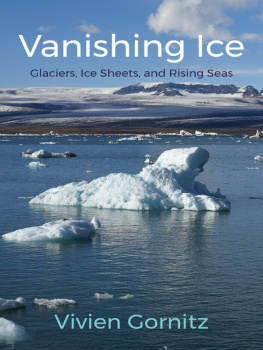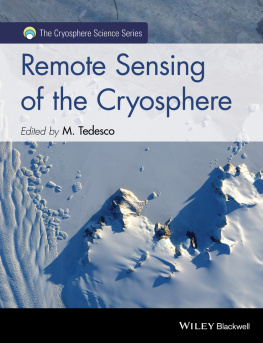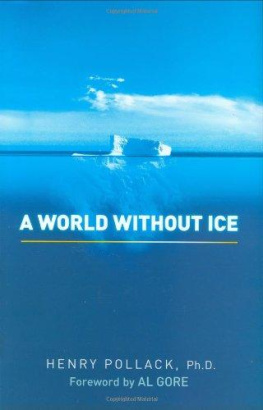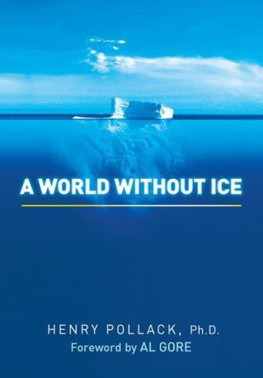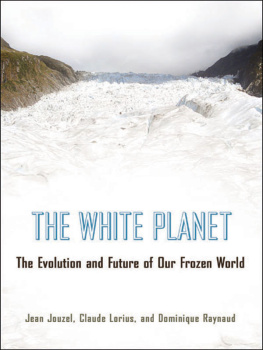Table of Contents
VANISHING ICE
VIVIEN GORNITZ
VANISHING ICE
Glaciers, Ice Sheets, and Rising Seas
COLUMBIA UNIVERSITY PRESS
NEW YORK
Columbia University Press gratefully acknowledges the generous support for this book provided by Publishers Circle member David O. Beim.
Columbia University Press
Publishers Since 1893
New York Chichester, West Sussex
cup.columbia.edu
Copyright 2019 Columbia University Press
All rights reserved
E-ISBN 978-0-231-54889-2
Library of Congress Cataloging-in-Publication Data
Names: Gornitz, Vivien, author.
Title: Vanishing ice: glaciers, ice sheets, and rising seas / Vivien Gornitz.
Description: New York: Columbia University Press, [2019] | Includes bibliographical references and index.
Identifiers: LCCN 2018041938 | ISBN 9780231168243 (cloth: alk. paper) | ISBN 9780231548892 (ebk.)
Subjects: LCSH: Climatic changesArctic regions. | GlaciersClimatic factorsArctic regions. | Ice sheetsArctic regions. | Sea levelClimatic factorsArctic regions. | CryosphereHistory.
Classification: LCC QC903.2.A68 G67 2019 | DDC 551.6911/3dc23
LC record available at https://lccn.loc.gov/2018041938
A Columbia University Press E-book.
CUP would be pleased to hear about your reading experience with this e-book at .
Cover design: Milenda Nan Ok Lee
Cover photo: Simon Lane / Alamy
CONTENTS
W hy should we care about vanishing ice and snow? Vanishing Ice: Glaciers, Ice Sheets, and Rising Seas vividly describes how the atmospheric accumulation of greenhouse gases generated by human activities has already begun to affect the Earths climate, most visibly near the poles and on high mountains. Arctic temperatures rise twice as fast as in the rest of the world. A once-perilous journey through the fearsome, ice-laden Northwest Passage has lately turned into a leisurely summer cruise through open waters for a growing number of large commercial and tour ships. The giant luxury cruise ship Crystal Serenity, carrying over 1,000 passengers with a crew of nearly 600, repeated its record-breaking 2016 voyage through the Northwest Passage the following summer, in August 2017. A sharp decline in Arctic summer sea ice since the 1980s is just one of the most conspicuous manifestations of the changing cryospherethe world of iceas our planet warms. Some scientists foresee nearly ice-free summers in the Arctic Ocean within the next several decades! On top of the Greenland Ice Sheet, warmer summers expand the area that thaws, even if only briefly, as occurred in mid-July of 2012, when nearly the entire surface of the Greenland Ice Sheet melted. In spite of the rarity of such widespread events (the previous such incident occurred in 1889), the extent and duration of summer melting has grown significantly in recent years.
Arctic peoples notice changes in polar bear behavior and reindeer foraging habits. The stronger waves of a prolonged ice-free Arctic Ocean erode the shoreline, endangering scores of Native Alaskan fishing villages. The environmental changes impinge on the ability of indigenous Arctic populations to maintain traditional lifestyles. Sheila Watt-Cloutier, an Inuit spokeswoman, has emphasized how important snow and ice are to their traditional hunting culture. She declared: We are in essence fighting for our right to be cold.
The effects of deicing the permafrost sweep across the Arctic. Trees tilt at crazy angles like drunken sailors, coastal cliffs crumble, wave-battered shorelines wash away, highways buckle, buildings sag and collapse, and lakes in the tundra appear and disappear as the changing climate transforms the regional ecology, hydrology, and landscape. Thawing permafrost and ground instability also affect Arctic construction, transportation, tourism, and development. However, a mixed picture emerges. Shipping will benefit from increasingly ice-free waters and considerably shortened transportation routes, cutting costs substantially. Development of potentially vast Arctic oil and mineral resources will open up many opportunities. At the same time, development of as-yet-untapped mineral wealth exposes fragile tundra and wildlife to new stresses from which recovery may be difficult.
Ice tongues and shelves that ring much of Antarctica, as well as many high Arctic islands, and that hold ice sheets and maritime glaciers in check begin to thin and weaken. At least ten large, fringing ice shelves on the Antarctic Peninsula have crumbled one by one, like a pile of dominoes, since the 1990s. Tributary glaciers feeding the ice shelves have then accelerated seaward. On high mountain slopes around the world, most glaciers are also in retreat. Darkening peaks not only disappoint Alpine tourists, but also lead to more unreliable water supplies. Swollen spring river flows generate more flash floods. Also, as glaciers recede and alpine permafrost thaws, the high mountains become unglued, letting loose more rockfalls and avalanches.
The visible changes may be just the tip of the proverbial iceberg. As permafrost thaws, will greenhouse gases like methane or carbon dioxide bubbling up from soggy, unfrozen Arctic soils and the seabed reinforce the ongoing warming trend? Which of these two greenhouse gases matters more to the permafrost climate feedback? Will Arctic vegetation grow wetter or drier? These questions grip scientists in a heated debate, as described in a later chapter.
The ice-albedo feedback amplifies the unprecedented late twentiethearly twenty-first-century rise in Arctic temperatures and speeds up ice losses. Less summer sea ice means more open ocean water. An open, nearly ice-free broad expanse of open water reflects less sunlight, and instead absorbs more of the suns heat. As a result, more sea ice melts, which in turn allows additional escape of heat and moisture into the atmosphere. The associated feedbacks and their consequences make the Arctic a major crucible of climate change. But their reverberations echo far beyond the deep north, or other currently frozen realms.
Changing Arctic landscapes and endangered lifestyles are not the only reasons why the vanishing cryosphere matters. What does the thawing cryosphere portend beyond polar regions and high mountain peaks? As succinctly stated in 2012 by former National Oceanic and Atmospheric Administration official Jane Lubchenko, What happens in the Arctic doesnt stay in the Arctic. What happens there often affects people around the world. Melting ice and glaciers in Greenland can contribute quite significantly to sea level rise, which affects people in coastal areas around the world. Sea level rise represents the other side of the same coin of thawing ice sheets and glaciers. These two sides of the coin have been closely interwoven throughout most of geologic history, as initially outlined in Rising Seas: Past, Present, Future, and explored at greater length in Vanishing Ice: Glaciers, Ice Sheets, and Rising Seas. This close relationship continues today and will persist into the future.

